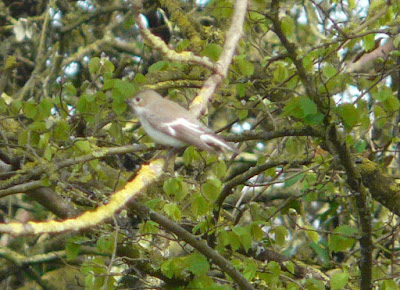A cold-toned female-type 'ficedula' flycatcher on Orcombe this afternoon. It shows a large white patch at the base of the primaries. The patch doesn't quite reach the edge of the wing though so whether it sits within range of pied or collared or both I'm not sure. I would of course be grateful for any comments on the bird. Below are a few more photos of it. I'm clearly nowhere near as clued-up on these species as I should be!
Not sure how much the light is making the rump look paler on this shot.
Black Redstart - dung field. Terry found this bird lunch time. It's the latest one I've ever seen on Orcombe. He also had Yellow Wagtail, Redstart and Whinchat up there today.
I did two trips up there today - a cold dawn trip before work and the later visit after work. Totals in a strong fresh easterly included 9+ Willow Warbler, 3+ Wheatear, 1 Whitethroat, 4 Blackcap, a flock of 42+ Linnet, the aforementioned Black Redstart and of course the Flycatcher.
Late news for Monday from the Imperial - c85+ Sandwich Tern, 52+ Whimbrel, 17+ Lesser Black-backed Gull and 2 Pale-bellied Brent Goose.









Hi Matt, following discussion last night here are some some good shots of a 2nd cy collared http://www.tarsiger.com/gallery/index.php?pic_id=SL1151482392&lang=eng even at this age the paler sides to nape are clear in collared and in most the white in wing still closer to outer primaries and contrast in white in tail against darker tail stronger. If you look at JanJ other links from JanJ lower in this thread: http://www.surfbirds.com/forum/showthread.php?5441-Female-Collared-Flycatcher-on-Bryher it shows variability in the white wing patch even in collared but that paler sides to nape is for me always a good feature to go on. Just an aside but having been to Crete x3 and other Greek Islands x3 during 2nd week and 3rd weeks in April it is males I was seeing with very small numbers of females appearing later in the period and then in early May in Turkey and Greek Islands only females.So this would be a bit early for a female Collared in NW Europe. There are other ficedula flycatchers to worry about though..
ReplyDeleteThanks Mike - as always hugely appreciate your comments.
ReplyDelete